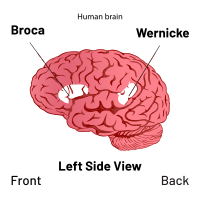
Photo from wikipedia
PURPOSE Many studies have reported the effects of constraint-induced movement therapy (CIMT) with an orthosis on the residual function of the impaired side of post-stroke patients. We encountered a case… Click to show full abstract
PURPOSE Many studies have reported the effects of constraint-induced movement therapy (CIMT) with an orthosis on the residual function of the impaired side of post-stroke patients. We encountered a case with left hemiparesis whose functioning of the impaired hand improved by CIMT with an orthosis not to assist as in the past but to restrict the residual function of the paralyzed fingers. METHODS The patient was a 46-year-old woman with left hemiparesis due to cerebral infarction 18 months ago. The patient had resumed work but would easily tire while typing the keyboard. We found that the extrinsic hand muscles were more engaged in compensatory movements than the intrinsic muscles. Therefore, we designed an orthosis that would extend and fixation the distal interphalangeal joint and proximal interphalangeal joint muscles to promote the engagement of the intrinsic muscles and restrict the compensatory movements of the extrinsic muscles. RESULTS The orthosis was used for 8 h/day for 2 weeks; CIMT were performed. Left hemiplegia improved from CIMT and the patient was able to handle the same amount of work as that before onset. CONCLUSION Restrictive orthosis on the paralyzed hand in combination with CIMT was found to be a beneficial rehabilitation approach.IMPLICATIONS FOR REHABILITATIONThis case suggests that not assistive but suppressive orthosis with constraint-induced movement therapy can be effective in strengthening the intrinsic muscles of the hand and restricting compensatory movements by the extrinsic muscles in hemiplegic patients.Treating the paralyzed side with a suppressive orthosis may be an effective novel approach for improving the physical function of the paralyzed hand in post-stroke patients.
Journal Title: Disability and rehabilitation
Year Published: 2023
Link to full text (if available)
Share on Social Media: Sign Up to like & get
recommendations!